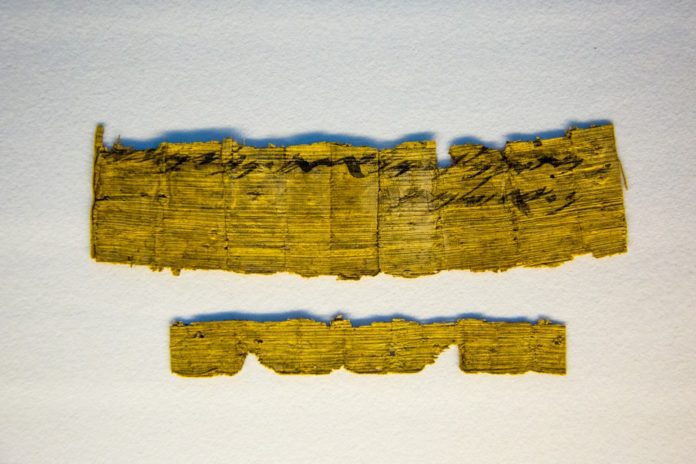Amid UNESCO’s Resolutions, Ancient Papyrus Highlights Jerusalem’s Jewish Past
Robbers looting from the caves of the Judean Desert is a phenomenon the Israel Antiquities Authority (IAA) has been contending with for years. But in a successful investigative operation, the IAA was able to save an illicitly plundered extra-biblical document from the hands of a band of antiquities robbers.
The IAA’s Unit for the Prevention of Antiquities Robbery, which was established in 1985, engaged in a complex enforcement operation in which they were able to seize an ancient papyrus document with ancient Hebrew writing from Palestinians looters excavating without a license in the Judean Desert caves. The looters, who came from the south Hebron Hills, were subsequently arrested and jailed.
“The IAA obtained information about the stolen papyrus and we were able to track the document down before it disappeared into some private collection,” explained Amir Ganor, the Director of the Antiquities Robbery Prevention Unit. “It was a long operation took place both in the Judean Desert and in the antiquities market,” he told Tazpit Press Service (TPS).
“At this time, the State of Israel is beginning a five-year process to crack down on the looters and protect the ancient treasures of the Judean Desert that have yet to be uncovered” Ganor commented.
Earlier in the year, the IAA, the Heritage Project of the Jerusalem Affairs Ministry and the Culture and Sport Minister Miri Regev began promoting a national plan for comprehensive archeological excavations in the Judean Desert caves including the Dead Sea scrolls. “I will work to increase the punishment against those that rob our country’s antiquities,” Regev had said. “It is our duty to protect these unique treasures, which belong to the Jewish people and the entire world.”
“It is our duty to take care of the plundering of antiquities that occurs in the Judean Desert, and no less important than this is exposing the deceit of false propaganda as is once again happening today in UNESCO,” Regev added today.
Indeed, on Wednesday, the ancient papyrus tracked down by Ganor’s unit, which dates back to the time of the First Temple in the seventh century BCE, was formally presented by the IAA. On the document, the ancient Hebrew inscription reads: “From the king’s maidservant from Nahartah, jars of wine, to Jerusalem.”
The document is the earliest extra-biblical source to mention the city of Jerusalem in Hebrew writing. Most of the letters are clearly legible and the paper was produced from the pith of the papyrus plant, according to Dr. Eitan Klein, the Deputy Director of the Antiquities Robbery Prevention Unit.
“The document represents an extremely rare piece of evidence of the existence of an organized administration in the Kingdom of Judah and highlights the centrality of Jerusalem as the economic capital of this kingdom,” Klein told reporters on Wednesday.
In light of the recent UNESCO resolution denying Jewish connections to holy sites in Jerusalem, Professor Shimon Ahituv from Ben Gurion University commented that the shipping document gives the international community a factual piece of evidence.
“It’s just a little note attached to two jars of wine from Naharat in the Jordan Valley sent to Jerusalem by a lady. But it is one of three papyruses we have from the period of the First Temple,” elaborated Ahituv. “The wines did not get to their intended recipients as something must have happened along the way somewhere around Jericho.”
“The UNESCO resolutions have nothing to do with reality. There was a Jewish monarchy here and that is what this ancient wine shipment document shows,” said Ahituv.






